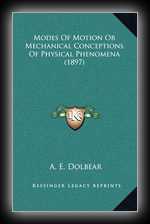
Modes of Motion
by A.E. Dolbear
1897
Excerpt:
...pendulum-bob, but that due to a change of form of the atoms within the molecule; otherwise there could be no such thing as spectrum analysis. Vibratory motion of the matter becomes undulatory motion in the ether. The vibratory motion we call heat ; the wave motion we call sometimes radiant energy, sometimes light. Neither of these terms is a good one, but we now have no others. It is conceded that it is not proper to speak of the wave motion in the ether as heat: it is also admitted that the ether is not heated by the presence of the wave; or, in other words, the temperature of the ether is absolute zero. Matter only can be heated. But the ether-waves can heat other matter they may fall on; so there are three steps in the process, and two transformations: (1) vibrating matter; (2) waves in the ether; (3) vibration in other matter. Energy has been transferred indirectly. What I want to impress in this is, when a form of energy in matter is transformed in any manner so as to lose its characteristics, it is not proper to call it by the same name after the transformation as before; and this we do in all cases when the transformation is from one kind in matter to another kind in matter. Thus, when a bullet is shot against a target, before it strikes, it has what we call mechanical energy, and we measure that in foot-pounds; after it has struck the target, the transformation is into heat, and this has its mechanical equivalent, but is not called mechanical energy, nor are the motions which embody it similar. The mechanical ideas in these phenomena are easy to grasp. They apply to the phenomena of the mechanics of large and small bodies, to sound, to heat, and to light, as ordinarily considered ; but they have not been applied to electric phenomena...
